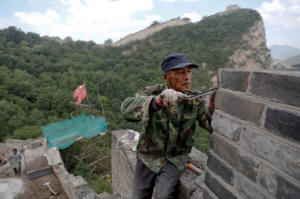|
China's Great Wall repaired with simple
tools, bricks of old
 Send a link to a friend
Send a link to a friend
 [June 19, 2017]
By Thomas Suen and Damir Sagolj [June 19, 2017]
By Thomas Suen and Damir Sagolj
BEIJING (Reuters) - At one of the most
treacherous and least restored stretches of China's Great Wall, a line
of pack mules halted upon emerging from the gloom of a dense forest
draped in mist and dew.
Laden with 150 kg (330 pounds) of bricks each, the seven animals finally
got moving in response to the coaxing and swearing of their masters,
eager to gain altitude before the sun climbed high in the sky.
For more than a decade, mules have been crucial in the effort to restore
Jiankou, a serpentine 20-km (12-mile) section of the wall about 70 km
(44 miles) north of central Beijing that is notorious for its ridges and
perilous slopes.
"The path is too steep and the mountains are too high, so the bricks can
only be transported by mules," said local mule owner Cao Xinhua, who has
worked on Great Wall restoration projects in the mountains north of
Beijing for 10 years.
Where they could, workers used the original bricks that had broken off
the wall over the centuries. When they found none, they used new bricks
made to exacting specifications.

"We have to stick to the original format, the original material and the
original craftsmanship, so that we can better preserve the historical
and cultural values," said Cheng Yongmao, the engineer leading Jiankou's
restoration.
Cheng, 61, who has repaired 17 km (11 miles) of the Great Wall since
2003, belongs to the 16th generation in a long line of traditional brick
makers.
A government clampdown on pollution has forced the closure of almost all
brick-making factories in Beijing and nearby provinces, Cheng said.
If he ran out of bricks, Cheng added, he would have to look for bricks
left elsewhere or request the central government to consider reopening
some brick factories.
CONCRETE PAVEMENT
Famed for its rugged beauty, Jiankou, which is Chinese for an arrow's
nock, or notch for a bowstring, was built in the twilight years of the
Ming dynasty in the 1600s, but is young compared with other sections
dating back two millennia.
[to top of second column] |

People work on the reconstruction of the Jiankou section of the
Great Wall, located in Huairou District, north of Beijing, China,
June 7, 2017. REUTERS/Damir Sagolj

Intensive repairs on the Jiankou section in the past year have been
led by the district government keen to preserve the wall's natural
beauty and shore up its disintegrating steps.
The restoration began in 2005 and is now in its third phase, making
slow progress because the uneven terrain allows use only of basic
tools such as chisels, hammers, pickaxes and shovels.
Authorities' meticulous approach followed widespread outrage last
year sparked by botched restoration efforts on some stretches.
Authorities in the northeastern province of Liaoning, home to a
700-year-old section of the wall, paved its ramparts with sand and
cement, resulting in what critics said looked more like a pedestrian
pavement.
Soon after, the State Administration of Cultural Heritage said it
would investigate any improperly executed wall preservation
projects.
Just a tenth of the wall built during the Ming dynasty has been
repaired, said Dong Yaohui, vice president of the China Great Wall
Association.
"In the past, we would restore the walls so that they would be
visited as tourist hot spots," he said, by contrast with today's
objective of repairing and preserving them for future generations.
"This is progress."
(Additional reporting by Irene Wang; Writing by Stella Qiu and Ryan
Woo; Editing by Darren Schuettler and Paul Tait)
[© 2017 Thomson Reuters. All rights
reserved.]
Copyright 2017 Reuters. All rights reserved. This material may not be published,
broadcast, rewritten or redistributed.
 |